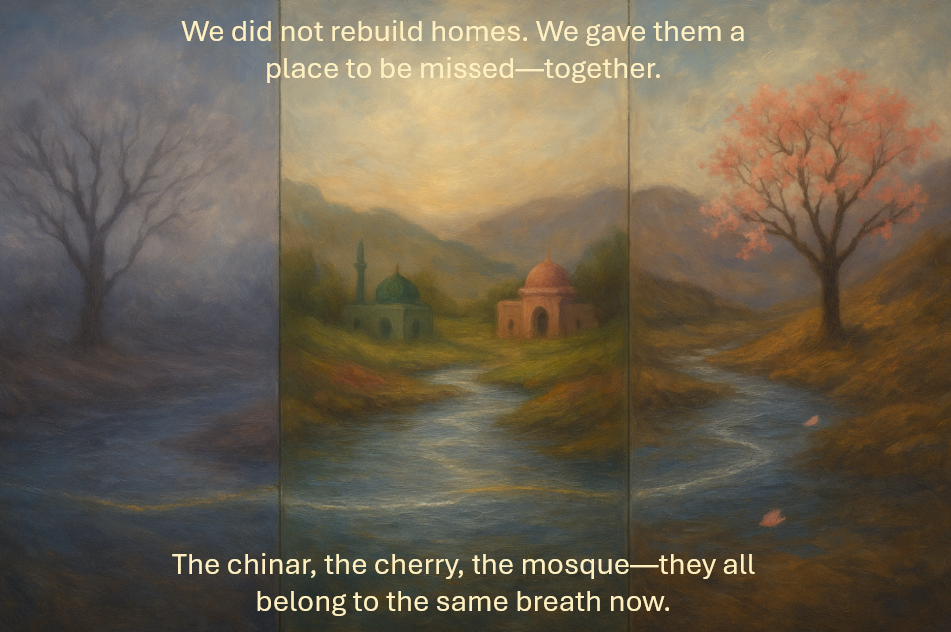
Return to Srinagar
The Circle returned from Muzaffarabad under a sky the color of wet ash, their footsteps heavier, their silence deeper. The bridge was already behind them, but the river had followed — in Zohair’s rabab, in the children’s echoed refrain, in the weight of consent given freely.
They did not speak of triumph. Only of carrying.
In Srinagar, the courtyard canopy fluttered like a lung after a long-held breath. Aisha unrolled the final canvas panel — the Srinagar sky now complete with a chinar’s ghost in violet, its branches dissolving into mist. In Jammu, Neelam had finished the valley floor: a silver river cradling mosques and temples in soft rose and emerald, their doors open to no one.
But now, something had changed.
The Third Mirror
Mina projected the new data: slips from Muzaffarabad now glowed alongside Srinagar and Jammu.
— Our cherry tree was cut for a road.
— The river took my brother’s name and never gave it back.
— I drew the house my father lost — it looked like yours.
The Quiet Box had become a triadic throat.
Sofia gathered the youth from all three sites via encrypted video — a fragile triangle of screens. A Srinagar girl held up her chinar. A Jammu boy showed his vanished mosque. A Muzaffarabad child raised a charcoal cherry tree.
No one spoke. They only showed.
Aisha dipped her brush in gold — not for justice, but for witness — and painted a thin, unbroken line across all three murals where the river met the horizon. The same river. The same breath.
The Night of Quiet Mapping
On June 22, under lantern light, the Circle hosted a silent mapping ceremony. No speeches. Only paper, charcoal, and the rabab’s echo from a small speaker — Zohair’s voice, recorded with permission, now a fourth presence.
Participants wrote street names, tree species, prayer times, lullabies. They drew doors that opened inward. They folded the papers and dropped them into the Quiet Box.
An elder from Jammu whispered to Neelam: “I prayed in that mosque. You drew it better than memory.”
A Srinagar mother touched the chinar: “My son was born under its shade. He’s never seen it.”
A Muzaffarabad boy added: “We have a tree like that. They call it chinar too.”
The river, projected in real-time via Mina’s drone feed, flowed across all three walls — a living silver thread binding the murals.
The Final Stroke
On June 25, Aisha stood before the Srinagar mural and added one last element: a small, open door in the chinar’s trunk, painted in the exact rose of Neelam’s sari. In Jammu, Neelam painted a cherry blossom drifting into the river. In Muzaffarabad, a child mailed a slip: I left a petal in the water. Did it reach you?
Emil closed the ledger.
We did not rebuild homes. We gave them a place to be missed — together.
Ledger Entry — Homes That No Longer Exist
Date: June 26, 2026
Symptom: Triadic grief mapped across Srinagar, Jammu, and Muzaffarabad; homes vanish into shared memory.
Disease — The Four Absences (Tri-Valley Context):
- Absence 1 (Exclusion): Exile triplicated — geographic, historic, emotional.
- Absence 2 (Vengeance): Pain risks triangulation; mapping redirects to witness.
- Absence 3 (Dehumanization): “Refugee,” “occupant,” “displaced” — labels erased by named doors and trees.
- Absence 4 (Unheard Cry): Vanished homes now spoken in three tongues, one river.
Investigator’s Response:
Facilitated tri-site testimony mapping; integrated Zohair’s song as living current; completed “Mirror of Valleys” with shared river-horizon; established silent witness protocol.
Outcome:
Three murals aligned; 312 named homes mapped; cross-border consent sustained; emotional trust triangulated.
Note:
The river carried the petal. The door stayed open. The chinar, the cherry, the mosque — they all belong to the same breath now.
The Jhelum flowed on, no longer a border, but a keeper of open doors.

